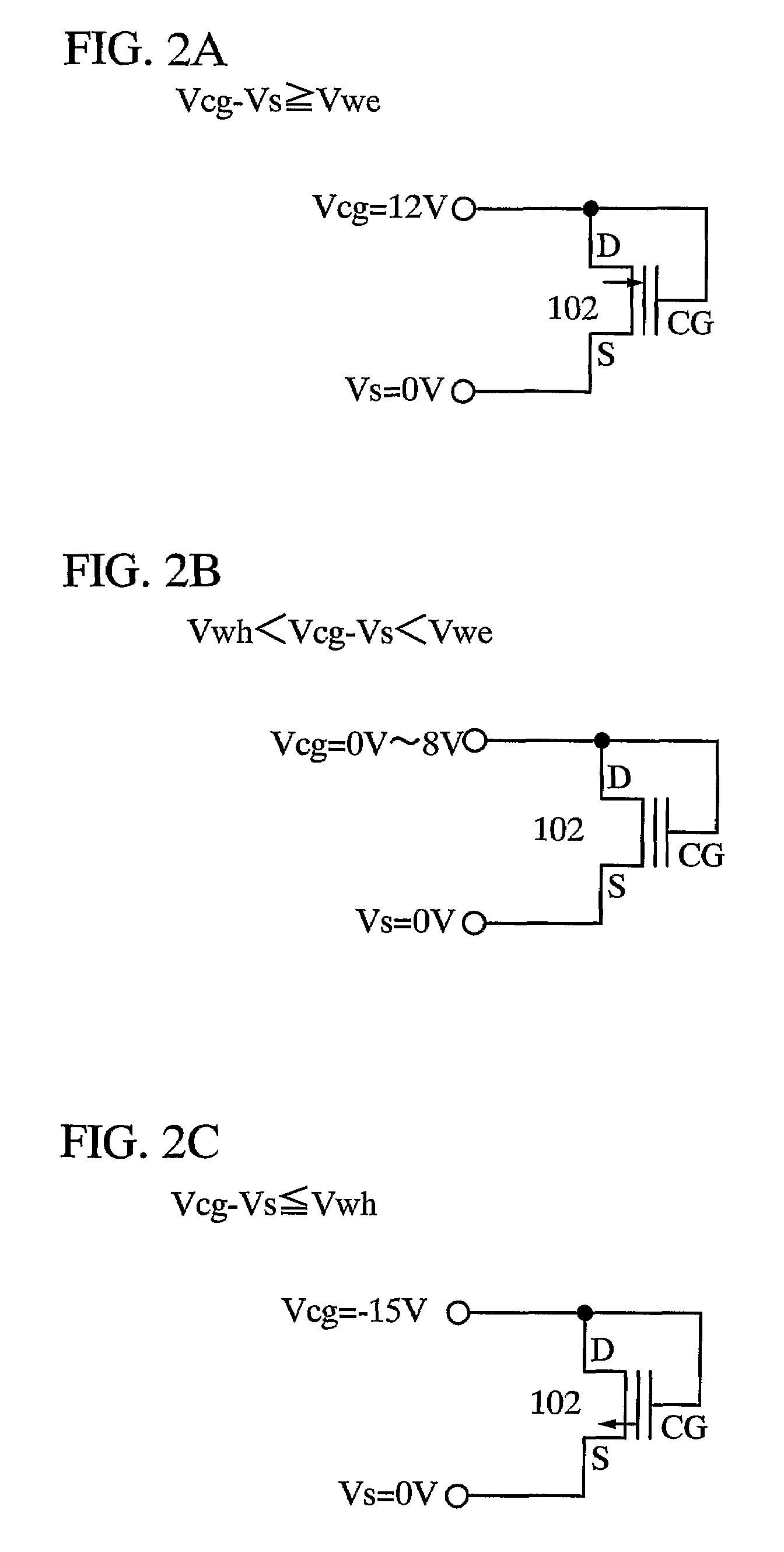Limiter and semiconductor device using the same
a limiter and semiconductor technology, applied in the field of limiters, can solve the problems of difficult control of limit voltage accuracy, difficult to prevent dielectric breakdown of integrated circuits, and excessive ac voltage over a predetermined range in antennas, so as to reduce the cost of semiconductor devices, accurate limit voltage, and prevent the effect of being broken
- Summary
- Abstract
- Description
- Claims
- Application Information
AI Technical Summary
Benefits of technology
Problems solved by technology
Method used
Image
Examples
embodiment 1
[0083]Described in this embodiment is a limiter of the invention using a plurality of diode-connected transistors.
[0084]FIG. 5A is a circuit diagram of a limiter of this embodiment. In FIG. 5A, reference numeral 401 denotes a resistor, and 402 and 403 denote diode-connected transistors. The transistors 402 and 403 each has a floating gate (FG) and a control gate (CG). Although the transistor 402 and the transistor 403 are both N-channel transistors in FIG. 5A, one or both of them may be P-channel transistors. In either case, all the diode-connected transistors are connected in series so as to have the same forward current direction.
[0085]A voltage Vin from an input terminal is supplied to a first terminal of two terminals of the resistor 401. The transistor 402 and the transistor 403 are connected in series so as to have the same forward current direction. Specifically in FIG. 5A, the control gate and a drain (D) of the transistor 402 are connected to a second terminal of the resist...
embodiment 2
[0102]According to the invention, even when other semiconductor element is provided between a control gate and a drain of a transistor, the transistor can be considered to be diode connected as long as it functions as a diode. Described in this embodiment is an example where other semiconductor element is provided between a control gate and a drain of a transistor used in a limiter.
[0103]FIG. 6A is a circuit diagram showing an example of the limiter of this embodiment. In FIG. 6A, reference numerals 431 and 433 denote resistors, and 432 denotes a transistor. The transistor 432 has two gates of a floating gate (FG) and a control gate (CG). In FIG. 6A, the transistor 432 is an N-channel transistor.
[0104]A voltage Vin from an input terminal is supplied to a first terminal of two terminals of the resistor 431. The resistor 433 is connected between the control gate and a drain (D) of the transistor 432. The drain of the transistor 432 is connected to a second terminal of the resistor 431...
embodiment 3
[0113]Described in this embodiment is a limiter of the invention using an operational amplifier.
[0114]FIG. 7 is a circuit diagram showing an example of the limiter of this embodiment. In FIG. 7, reference numeral 451 denotes a resistor, 452 denotes a diode-connected transistor, and 453 denotes an operational amplifier. The transistor 452 has two gates of a floating gate (FG) and a control gate (CG). In FIG. 7, the transistor 452 is an N-channel transistor.
[0115]A voltage Vin from an input terminal is supplied to a first terminal of two terminals of the resistor 451. The control gate and a drain (D) of the transistor 452 are connected to a second terminal of the resistor 451. A source (S) of the transistor 452 is supplied with a constant voltage such as a ground (GND).
[0116]The second terminal of the resistor 451 is connected to a non-inverting input terminal of the operational amplifier 453. An inverting input terminal of the operational amplifier 453 is connected to an output termi...
PUM
 Login to View More
Login to View More Abstract
Description
Claims
Application Information
 Login to View More
Login to View More - R&D
- Intellectual Property
- Life Sciences
- Materials
- Tech Scout
- Unparalleled Data Quality
- Higher Quality Content
- 60% Fewer Hallucinations
Browse by: Latest US Patents, China's latest patents, Technical Efficacy Thesaurus, Application Domain, Technology Topic, Popular Technical Reports.
© 2025 PatSnap. All rights reserved.Legal|Privacy policy|Modern Slavery Act Transparency Statement|Sitemap|About US| Contact US: help@patsnap.com



